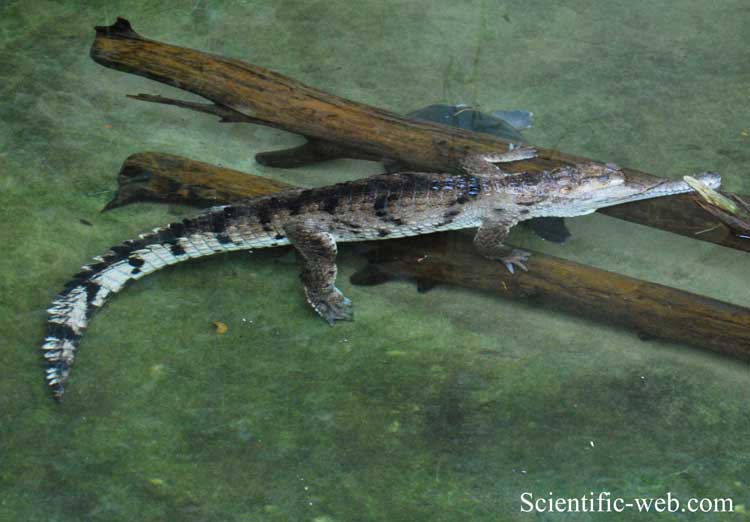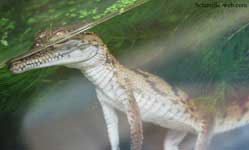Crocodylus johnstoni, Photo: Michael Lahanas Superregnum: Eukaryota Name Crocodylus johnstoni Krefft, 1873
Vernacular names --------- The freshwater crocodile (Crocodylus johnsoni or Crocodylus johnstoni; see below), also known as the Australian freshwater crocodile, Johnston's crocodile or colloquially as freshie, is a species of reptile endemic to Australia. Found in the northern regions of Australia, it is much smaller than the other Australian species, the saltwater crocodile, which is responsible for attacks on people. Although they will bite if disturbed or feel threatened, freshwater crocodiles are not known as man-eaters and their prey is generally of a much smaller size. However as prey for larger adults can include wallabies, small children should not be left unattended in their presence, although no such attacks have been reported. They will usually ignore people when sunning themselves beside a swimming hole, provided they have a relatively peaceful spot. The Australian freshwater crocodile is a relatively small crocodilian. Males can grow to around 3 metres (9.8 ft) long, while females reach a maximum size of 2.1 metres (6.9 ft).[3] In areas such as Lake Argyle and Katherine Gorge there exist a handful of confirmed 4 metres (13 ft) individuals, but even at this relatively large size this species is shy and has a much more slender snout than the very dangerous saltwater crocodile. The body colour is light brown with darker bands on the body and tail — these tend to be broken up near the neck. Some individuals possess distinct bands or speckling on the snout. Body scales are relatively large, with wide, closely-knit armoured plates on the back. Rounded, pebbly scales cover the flanks and outsides of the legs.[3] Attacks on humans The Freshwater Crocodile, whilst it does not attack humans as potential prey, can deliver a nasty bite. There have been a (very limited) number of incidents where people have been bitten whilst swimming with freshwater crocodiles, and others incurred during scientific study. An example of a recorded attack by a freshwater crocodile on a human took place at Barramundi Gorge (also known as Maguk) in Kakadu National Park and resulted in very minor injuries to the victim, who managed to swim and walk away from the attack. It is believed the victim swam directly over the small crocodile. However in general it is still considered safe to swim with this species, so long as they are not aggravated .[4] Distribution and habitat They are found in the states of Western Australia, Queensland, and the Northern Territory. Main habitats include freshwater wetlands, billabongs, rivers, and creeks. It competes poorly with Saltwater crocodiles but is saltwater tolerant. As an adult its diet consists of birds, bats, reptiles, amphibians and fish, although larger individuals may take prey as large as a wallaby. This species can be found in areas where Saltwater Crocodiles cannot and are known to inhabit areas above the escarpment in Kakadu National Park and in very arid & rocky conditions (such as Katherine Gorge, where they are very common and relatively safe from saltwater crocodiles during the dry season.) That being said, they are still consistently found in low-level billabongs, living alongside their larger evolutionary cousins. Conservation and concerns Commemoration When Gerard Krefft named the species in 1873, he intended to commemorate the first European to discover it and report it to Krefft, whose name was Johnston. However, Krefft made an error, and according to the rules of the International Code of Zoological Nomenclature, the specific epithet johnsoni (rather than the intended johnstoni) is correct.[3] References 1. ^ Crocodile Specialist Group (1996). Crocodylus johnsoni. In: IUCN 1996. IUCN Red List of Threatened Species. Downloaded on January 31, 2010. Source: Wikispecies, Wikipedia: All text is available under the terms of the GNU Free Documentation License |
|


